|
|
|
|
|
|
|
Achi-Kochi Japan
Showing many places to visit and foods to eat in Japan
|
|
|
|
|
|
|
|
|
|
|
|
|
Japan
> Kyushu region
> Nagasaki City
|
|
|
|
|
|
|
Nagasaki City
Nagasaki Pref., Kyushu ( Achi-Kochi Japan )
|
|
|
|
|
|
|
|
|
|
|
|
|
( "Achi-Kochi" in Japanese means "Here and there" in English. )
Nagasaki City
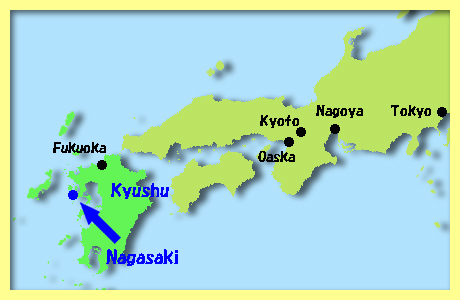
Nagasaki ( above ), where more than 400,000 people live, is the capital city of Nagasaki Prefecture, located in the west of Kyushu Region. Nagasaki has been one of the most important and influential port cities in Japan for a number of centuries and there remain many sites related to its history and popular among tourists.
|
|
2nd Atomic Bomb
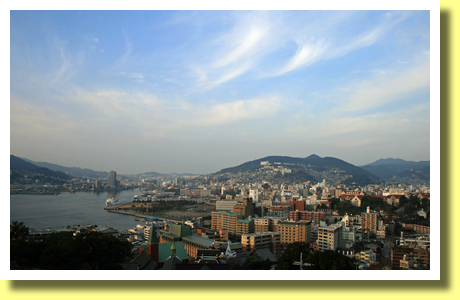
On 9th August 1945, three days after the first atomic bomb was dropped over Hiroshima, U.S. Bombers left Tinian carrying "Fat Man" which was a code name of the atomic bomb. Their target was Kokura ( now Kitakyushu City located in the north of Kyushu Region ). It was found that Kokura was too cloudy. So they flew to Nagasaki ( above ), their secondary target.
"Fat Man", the atomic bomb, exploded at 11:02 am on the day over Nagasaki City ( above ), where lived about 240,000, among whom 74,000 were killed and 80,000 injured.
|
|
Nagasaki Peace Park and Peace Statue
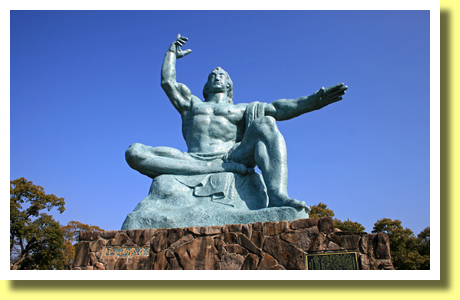
On 09th August every year, many people attend Peace Memorial Ceremony, held in front of Peace Statue ( above ). His right hand connotes the threat of nuclear weapons. On the contrary, his left hand, extended, indicate peace, eternal. The statue was completed in A.D.1955.
Peace Statue stands in Nagasaki Peace Park where located is a black monolith showing the epicentre of the explosion of the atomic bomb.
Also there in the park are Nagasaki Atomic Bomb Museum, Memorial Hall for the Atomic Bomb Victims, Peace Fountain and many more memorials.
|
|
Urakami Cathedral

The explosion of the atomic bomb destroyed lots of buildings including Urakami Cathedral, which was completed in A.D.1925 and which was located 500 meters from the epicentre. The above photo shows remnants of bell tower of the cathedral. Also a damaged pillar of the cathedral stands in Nagasaki Peace Park.
In A.D.1959, the cathedral was reconstructed, inside of which there are some relics such as the surviving head of a Saint Mary statue and a bell while charred stone saints stand near the cathedral as they did before the explosion.
|
|
Twenty Six Martyrs Monument
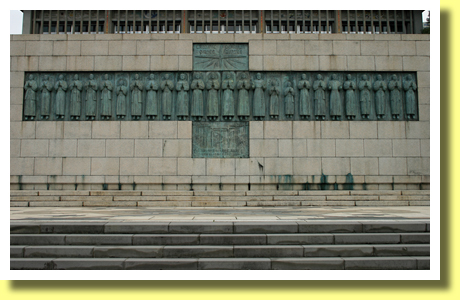
In A.D.1570, Sumitada Omura, a local warlord, opened Nagasaki Port for international trade and the first Portuguese ship arrived next year. In A.D.1580, the warlord allowed Society of Jesus to control Nagasaki City where lots of Japanese Christians lived. However it caused the execution of the twenty six Christians in A.D.1597 in Nagasaki where stand Twenty Six Martyrs Monument ( above ).
Hideyoshi Toyotomi, a powerful warlord who was unifying Japan at the time, oppressed warlords in Kyushu in A.D.1587 when he was informed of the situation of Nagasaki City being controlled by Society of Jesus as well as the number of Japanese Christians was increasing in the area. So he issued the edict to expel missionaries.
However his edict failed to be executed effectively. In addition, the pilot of a Spanish ship wrecked in A.D.1596 said missionaries were to lead an invasion. Then Hideyoshi Toyotomi, who had unified Japan in A.D.1590, made twenty six Christians, including six European priests/monks, martyred in Nagasaki in A.D.1597. In A.D.1862, twenty six martyrs were canonized.
|
|
Fumie
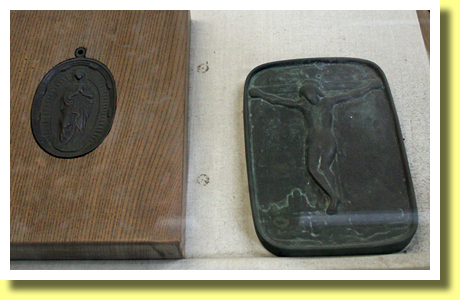
After Hideyoshi Toyotomi died in A.D.1598, Ieyasu Tokugawa established Tokugawa Shogunate in Edo ( Tokyo now ) in A.D.1603 ( ==> A History of Japan vol.2 Samurai Age ). The Shogunate oppressed Christians, especially Catholics, much further than Toyotomi did. Catholicism was banned. The Shogunate forced people to step on Fumie ( tablets bearing Christian images - above are replicas exhibited in former Latin Divinity School, located near Oura Church ).
Those, who failed to step on Fumie, are recognised as Christians and were ordered to abandon their religion. Those, who refused to do so, were tortured, expelled or executed. Missionaries were expelled, tortured and/or executed. The movie "Silence" based on the novel by Shusaku Endo describes the oppression.
|
|
Kakure Kirishitan ( hidden Christians )

In A.D.1863, two French priests arrived in Nagasaki, who built a Catholic church "Oura Church" next year. In A.D.1865 some Japanese visited the church and hoped to see the statue of Virgin Mary. It was discovered that they were Kakure Kirishitan ( hidden Christians ) living in Urakami area. The relief placed below the church shows the scene ( above ).
Kakure Kirishitan ( hidden Christians ), living in Nagasaki City and its surrounding areas, had kept their faith although there had been no church nor priest in Japan for over two centuries since the 1st half of the 17th century.
However Christianity was prohibited at the time by Tokugawa Shogunate. Even after the Shogunate was overthrown in A.D.1868, the new Meiji government banned the religion. More than 3,000, who had been found Kakure Kirishitan, were exiled. It was in A.D.1873 that the ban was lifted and those exiled were allowed to go home.
|
|
Oura Church

The above photo shows Basilica of the Twenty-Six Holy Martyrs of Japan ( Oura Church ), where Kakure Kirishitan visited in A.D.1865. The original building of the church was completed in A.D.1864 and reconstructed in A.D.1875. In A.D.1945, the basilica was not destroyed but damaged by the atomic bomb explosion and it was repaired in A.D.1952.
Now so many tourists visit the basilica, which is one of designated National Treasures of Japan and included in one of UNESCO World Heritage Sites. Christian Musiam ( former Latin Divinity School ), located next to the church, exhibits items related to Kakure Kirishitan ( hidden Christians ) including Fumie replicas.
|
|
Dejima
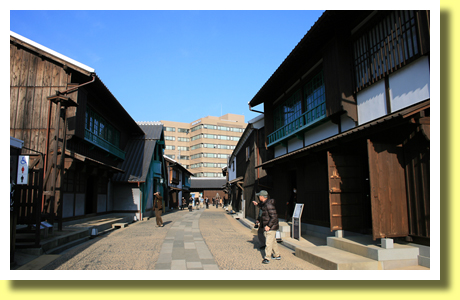
Because of the serious misgivings about the influence of European people and Christianity upon Japanese people, Tokugawa Shogunate issued several edicts to strengthen its national seclusion policy through A.D.1633-1636 and constructed Dejima, a small man-made island in Nagasaki port. The above photo shows the site of Dejima where historical buildings were reconstructed though Dejima, surrounded by reclaimed ground, is not an island any more.
The national seclusion prohibited foreign ships to enter any port in Japan and European people to land or live in Japan except a few exceptions under strict restrictions. Portuguese ships were allowed to enter only in Nagasaki port and Purguguese traders were allowed to live just in Dejima.
However in A.D.1639 the Shogunate expelled Portuguese. Instead Dutch ships were allowed to enter Nagasaki port and Dutch traders were moved to Dejima from Hirado in A.D.1641. Then Nagasaki was the only window of Japan open to the other countries until the national seclusion of Japan was ended in A.D.1854. Then French priests constructed Oura Church where Kakure Kirishitan visited in A.D.1865.
|
|
Glover Residence
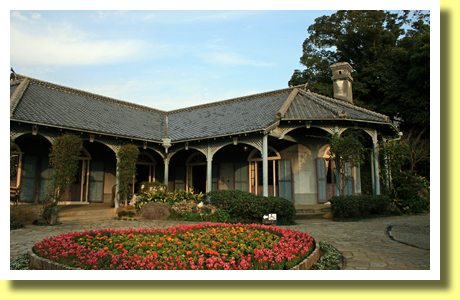
After the end of the national seclusion, many European merchants arrived in Japan, including Thomas Blake Glover, a British, who arravied in Japan in A.D.1859 and traded in arms as well as worked in shipbuilding and brewing. He built a residence ( "Glover Residence" - above ) on the hillside in Nagasaki City in A.D.1863. The residence is now one of the designated National Important Cultural Properties of Japan.
The site of Glover Residence is now a part of Glover Garden, which is an open-air museum, so popular among tourists. In the garden located are some buildings constructed by Europeans who lived in Japan after the end of national seclusion. Ringer House was built in A.D.1865, Alt House in A.D.1865-1867 and so on. The garden is located on the hillside where visitors could enjoy viewing Nagasaki City.
|
|
Tojin Yashiki ( Chinese Quarter )
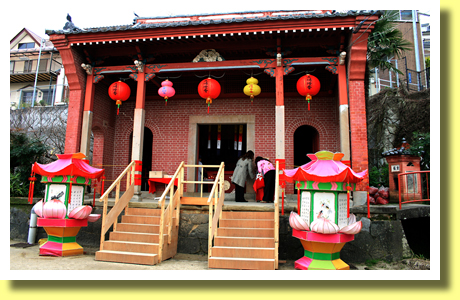
During the era of national seclusion of Japan, Chinese people lived in Nagasaki and worked in trade activities. They lived not in Dejima but in Tojin Yashiki ( Chinese Quarter ), which was constructed in A.D.1689. In the site of former Tojin Yashiki remain some structures built by Chinese people such as Kannon-do shrine ( above ) built in A.D.1787.
|
|
Nagasaki Shinchi Chinatown
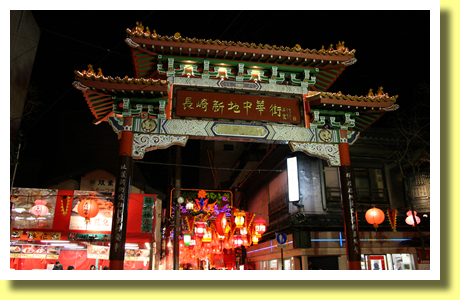
Many storehouses for Chinese ships were burnt down in A.D.1698. So to build new storehouses, reclaimed were some areas near Tojin Yashiki. The reclaimed areas were named "Shinchi" ( new land ). After the end of national seclusion, Chinese people came out of Tojin Yashiki and moved to Shinch, where the oldest Chinatown ( above ) in Japan is located.
In Shinchi Chinatown, most of the storehouses were demolished and now there are many Chinese restaurants and shops in Nagasaki Shinchi Chinatown, which is so popular among tourists.
|
|
Nagasaki Lantern Festival
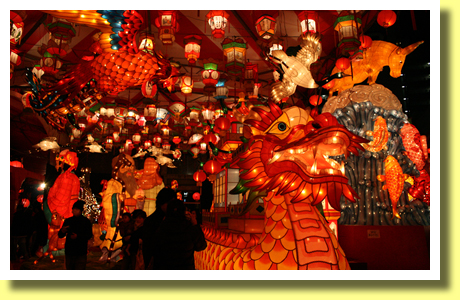
During 15 days starting on Chinese New Year ( dates vary by year ), so many people visit Nagasaki to see Lantern Festival ( above ). In the period, more than 15,000 Chinese Lanterns decorate Shinchi Chinatown and its surrounding areas. Also visitors could see Dragon Dance, Emeperor's Parade, Chinese Acrobatics, Lion Dance and so on.
|
|
Sofuku-ji Temple
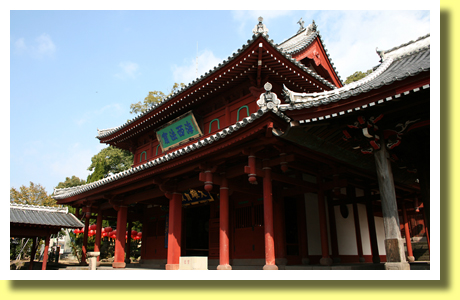
Sofuku-ji Temple was founded in Nagasaki City in A.D.1629 in a Chinese architectural style by Chinese people. There remain many structures in the site of the temple. Among them, there are two designated National Treasures of Japan - Inner Gate built in A.D.1696 and Main Buddha Hall ( Daiyuho-den - above ) constructed in A.D.1646, which enshrine many old Buddhist Statues. There are a few more old temples ( Kofuku-ji, Shofuku-ji and Fukusai-ji ) founded by Chinese people in Nagasaki City.
|
|
Megane-bashi Bridge

Megane-bashi Bridge ( above ), popular among tourists, was constructed in A.D.1634 by a Chinese Buddhist monk. "Megane" in Japanese means "Spectacles" in English. So "Megane-bashi" means "Spectacles Bridge". The bridge was dameged a few times by floods and repaired. Now the bridge is one of designated National Important Cultural Properties of Japan.
|
|
Champon
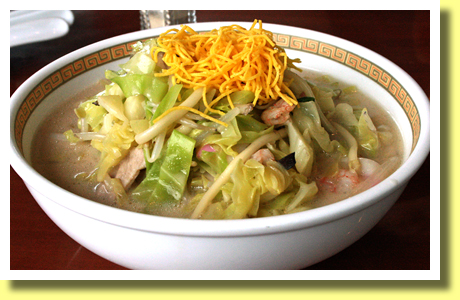
Champon, the most famous and popular regional specialty of Nagasaki, was first served in a Chinese restaurant "Shikairo" in Nagasaki in A.D.1899. The above photo shows champon served in Shikairo restaurant. Champon ( or Chanpon ) is noodles served with seafood, meats and vegetables in a thick soup. There are many restaurants, serving Champon, in Nagasaki City.
Also Sara Udon Noodles, another specialty of Nagasaki, are popular in Japan. Sara Udon is crisp fried noodles topped with a thick sauce and various ingredients. It is said that Sara Udon was first served in Shikairo restaurant as Champon was.
|
|
Shippoku
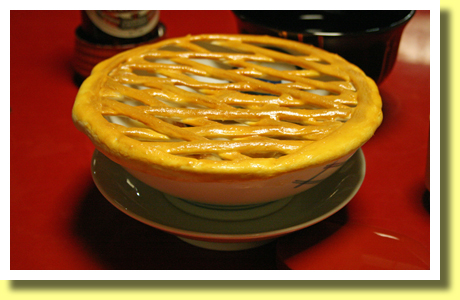
Shippoku was originated in Nagasaki in the 17th century. Although Shippoku is a variety of Japanese cuisine, it is a mixture of elements of Chinese, European and Japanese. So Shippoku could be originated not in anywhere else but in Nagasaki. Shippoku is even now one of local specialty dishes of Nagasaki. The above photo shows one of Shippoku dishes served in a restaurant in the city.
|
Copyright (c) 2021 Achi-Kochi Zanmai Co., Ltd.
|